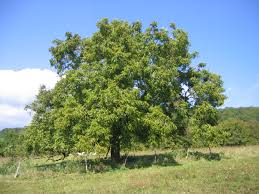This will be a short series of some of the charactaristics of the walnut and what can be done with them. It is important to know a walnut is not a tree to be trifled with. It does not reach a ripe old age the same as a Red Wood does and it has many specialty needs and requirements in regards to soil viability, placement, neighboring plants and other trees. Choose this tree based on research of site conditions not on a whim. We have had to abandon some canopy sites because they just are not a good fit.

Walnut trees grow to be between 33 and 131 ft. They also have a massive spread of up to 50 ft or 10m. They are in the genus Juglans and they have delicious nuts and beautiful wood.
There are a total of 21 species of walnut trees in the walnut family Juglandaceae. Some of the most common are the black walnut, the Andean walnut, the Japanese walnut, and the little walnut. They are native to North America, Asia, China, and Europe.
The fruit of a walnut is a drupe. The nut is the seed of the walnut tree’s fruit. The fruit has outer fleshy green husk surrounding a hard shell that contains a seed. This is not unsimilar to the peach. The wood of the walnut is prized for cabinets, bowls, veneer, and is a beautiful grain.
The Black Walnut is poisonous to many surrounding plants. They grow to between 75-130 ft and live to be about 130 years old. They are good in zones 4-9 which composes the climate of the PNW.
The English Walnut is next in our search. Chandler, Hartley, Howard, Tulare, Serr,
and Vina are some of the varieties.
The English walnut is cultivated extensively for its fine-quality edible seeds, sold commercially as walnuts. The dark fine-grained wood, similar to that of black walnut (Juglans nigra), is used for furniture, paneling, and gunstocks.
Soil conditions and ph are important for walnut trees and lime or other additives can be used to help amend the soil. It is not a good tree for a poorly draining area or a clay soil loamy or sandy types of soil are a better fit. Many plants will fail as well as trees because of the high toxicity of the Black Walnut. It is important to use extreme care when planting these. The other walnuts have lower toxicity levels but, do still share some level of toxicity. These trees are frequently planted in a grove together where there is no danger. There are plants that can be close to them. Some of the dwarf fruit trees and other bushes. Not blackberries, blueberries, or apples for sure.

https://wikifarmer.com/
